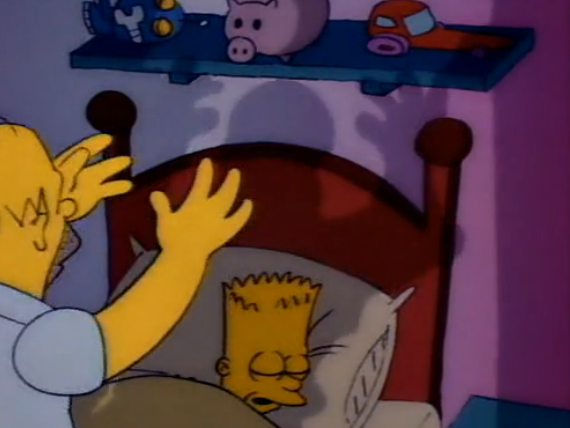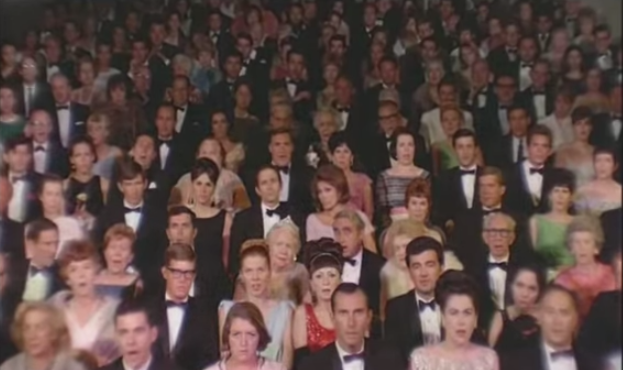In Which
Homer is Embarrassed by the Family
Vitals
Title:
There’s No Disgrace Like Home
Air Date:
January 28, 1990
Episode
No.: 7G04
Writer: Al
Jean and Mike Reiss
Director:
Greg Vanzo and Kent Butterworth
Lets get this out of the way, this
episode is funny, in fact I was caught off-guard by how funny it was. The
reason I was so surprised is because, like most people, what I remember most
about this episode besides the therapy scene (more on that later) is Homer and
Marge role and personality reversal. Given what the show was at the time, with
Homer more concerned about keeping up appearances despite his short fuse, and
Marge not yet required to be the responsible wonder woman trying to keep Homer
in one piece, the premise of this episode seems much more natural. It
exaggerates some character traits that were eventually dropped, but with the
proper open attitude its easy to enjoy the episode despite the off-character
craziness.
So, despite
more than 20 years of episodes showing us that There’s No Disgrace Like Home doesn’t fit into the larger series,
lets just accept it as it is and take a look at a very entertaining episode. *
The premise
is simple, in fact, considering it ends with a baby in an electroshock therapy
machine, the scale of the episode is about as small as The Simpsons it gets.
Its company picnic day at Mr. Burns’ mansion and Homer, dressed in a great
striped red and white picnic wear, is stressed out by his family’s boorish
behavior. We start with Bart and Lisa are fighting over who loves Homer the
most (“You do! No you do!). It’s not an especially novel joke, but it’s well
timed and acted and earns a laugh.
A quick trip
to the kitchen to pick up five gelatin desserts (Mr. Burns complimented Marge’s
jello once) and they are off. In the first season the animators loved using
distorted perspectives to change the appearance of their characters, and the
jellos are one of the best props they ever got to show of that gag, which works
especially well with the less refined animation of the first season. Maggie
looking through her pink blob is especially funny.
When the
Simpson’s arrive at the mansion, Burns is greeting the guests doling out
judgment. Burns orders Smithers to fire one man (who looks like he should have
been rejected for a cartoon from the 1960s) because his son says he doesn’t
want to be there.** Homer, just barely, navigates the family past Mr. Burns,
and spends the picnic chasing the kids and tackling Bart to prevent him from
beating Burns in a sack race. Meanwhile Marge wanders off and gets drunk with
the other women and dances down a staircase.
At the end
of the event, Homer is forced to watch another family happily leaving together,
and literally sees them ascend into the sky on a beam of heavenly light, while
his family turns into flame-pointed demons (with a great music cue), who he
must join on a drive home across a smoldering hellscape.
Does it get any better than this?
After their
near miss at the picnic Homer is more obsessed than ever with his family’s
behavior. When he arrives home from work to find Marge and the kids eating TV
dinners in front of Itchy & Scratchy, he springs into action dragging them
into the dining room for a disastrous dinner. When Lisa says, “The sad truth is
all family’s are like us,” Homer goes off the deep end and drags the family on
a Peeping Tom tour of the neighborhood. They see a rich, happy family enjoying
each other’s company (in a beautifully animated home), but they are forced to
flee another yard after (hilariously) assuming that a conversation about getting
the gun to chase them off is actually about love.
Perhaps the
best joke in episode comes when the family arrives at yet another window. There
is no one to be seen, but they mock the family that lives in the shabby house and Homer is gleefully
stomping their flowers. Then Marge says its their house and they give up for
the evening. Despondent, Homer ends up at Moe’s. While the rest of the barflies
watch a boxing match, Barney tries to commiserate with Homer, but after he
calls Bart and Lisa crummy and they get in a fight, which Barney quickly end
with a blow to the head that leaves Homer’s spinning.
Homer comes
to at the exact moment that the smooth voice of Dr. Marvin Monroe comes on the
television advertising his therapy services (“Family bliss or double your money
back!). Homer, as he’s wont to do, takes this as some sort of divine
inspiration and rushes home to get the family and come up with $250 for the
treatment. Over the protests of Bart, Lisa, and Marge, he breaks open the
college fund ($88.50 – Lisa will need a partial scholarhip).
Then it’s
off to the pawnshop to do the unthinkable, sell the family television. Marge
would rather pawn her engagement ring, but Homer won’t hear of it, they need
$150 and the ring won’t do it. The shop looks like something out of Dr. Suess,
full of appliances, and musical instruments, and a dozen other things. The best
part of the trip though is the clerk, who looks and sounds completely crazy.
There’s no textual joke, he’s just awesomely weird. They get the money with a
promise that the TV is cable ready.
Dr.
Monroe’s office looks great also, with a smart background cameo from the
perfect family who had ascended into heaven at the the picnic. We also get a
meta visit from Dr. Monroe’s latest satisfied clients, who look suspiciously
like the Simpson family, off to have frosty chocolate milkshakes and celebrate
their “new found ability to express love for each other.”
At this
point the Simpsons join Dr. Monroe for one of the best remembered, and funniest,
scenes of the first season. Marvin Monroe is probably has one of the weirder
arcs of any Simpsons character. He is remembered today more as a joke, presumed
dead (but not particularly missed) for years, but very briefly reappearing in
season 15. If you listen to the DVD commentary you know that Dr. Monroe was
retired because the voice was painful for Harry Shearer to perform. Its also
clear though that he wasn’t very popular in the writer’s room.
Here Dr.
Monroe seems to be a reasonable effective therapist who is simply overwhelmed
by the dysfunction of the Simpsons. He starts by having the family draw the
root of their problems. Everyone pins the blame on Homer with their own amateur
portraits, while Home has already forgotten why they are there and draws a
plane. Next they try aggression therapy with foam rubber beating sticks, until Bart
realizes they would be more effective without the foam and hits Dr. Monroe in
the shin with a metal rod.
Finally, at
his wits end, Dr. Monroe attaches each member of the family, including Maggie,
to an electroshock machine that they are supposed to use to shock each other
when they are hurt emotionally. The entire setup looks great, its big and scientific
without seeming too fanciful. Plus the stuttering shock animation holds up well,
even if it looks quaint today. Before he can even explain the procedure the
family descends into shocking, brownout causing madness. Even Maggie gets in on
the act and illustrates why therapy is effective for babies (answer: they are
babies).
Dr. Monroe
has to unplug the machine and admit that the family can’t be helped. Homer, not
missing a beat, demands double their money back. Dr. Monroe hands it over just
to be rid of them. Naturally, Homer becomes the family hero when he announces
they are buying a newer, better television.
This is a
good episode, and it’s more important historically than people realize. The
therapy scene became the go to first season clip for years, for many people
that was the only first season clip they saw for years. Its also huge because
it’s the first episode that aired that gets the balance of family problems and
mocking humor. The episodes that preceded There’s
No Disgrace Like Home had more real stakes for the family that made the
reversion to the status quo at the end feel like a cheat. Here, the stakes come
from Homer’s slightly misguided concern about the family. He just needs to
loosen up a little bit and everything is fine. This allows the humor to flow
more naturally and brings the plot in better alignment with the comedic
sensibility. This is also the first episode, I think, where the animation truly
adds to the experience start to finish. There are suddenly fewer blank
background and odd angles, and the world is closer to having the grounding in
physical reality that is essential to the show from the second season onward.
I know that
there are many people who can’t stand this episode because Homer isn’t Homer,
and Marge isn’t Marge, and, despite concern that she won’t be going to Vassar,
Lisa isn’t Lisa. I’ve already said that I think that stance is misguided.
Seriously, if you want to see a good episode of television and a some very
smart writing, then forget what you know and give this one another try.
*This
doesn’t mean I couldn’t write multiple posts about the character development
oddness this episode creates. One in particular I can’t resist pointing out is
that Marge seems to love Itchy and Scratch as much as the kids here, but in the
second season episode Itchy &
Scratchy & Marge, discovers the show is incredibly violent and starts a
campaign to get it taken off the air.
**Given Mr.
Burns known disdain for family, its weird to see him care so much. Then again,
today’s Burns wouldn’t host a company picnic either.
Running Gags
The
Children’s Treasury of Amusingly Mundane Names
Dr. Marvin Monroe
Things That
Might Amuse No One But Me
My favorite
moment of the episode is, once again, made by the voice-acting. At the start of
the sack race, Smithers leans over to Mr. Burns and gives him a head start by
saying start just to him. The way that Smither excitedly whispers “Go Mr.
Burns!” cracks me up every time. I rewound and listened at least half a dozen
times today.
Jeff
Albertson’s Obsessive Watcher Moment
The first appearance
of Itchy & Scratchy is pretty tame. There is no elaborate set up or parody.
Scratchy chases Itchy and dives head first as if it was an episode of Tom and
Jerry (with the music to match), and Itchy gets him with a Looney Tunes style
bomb.
Animation
Corner
This is a
deceptively big episode for the animation. It’s the first episode to see air
that isn’t infected with blank, colored backgrounds on character close-ups,
which sounds like it might be small, but makes a huge difference. More
noticeably, Vanzo and Butterworth dive in with new lots of new sets and
character models, and bring out detail that elevates the spaces above the more
generic standards of the time. Dr. Monroe’s office is especially great.








